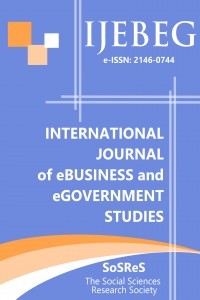TACIT KNOWLEDGE VISUALIZATION THROUGH ORGANIZATIONAL EXPLICIT KNOWLEDGE WAREHOUSES: A PROPOSAL FOR RESEARCH METHODOLOGY DESIGN AND EXECUTION
TACIT KNOWLEDGE VISUALIZATION THROUGH ORGANIZATIONAL EXPLICIT KNOWLEDGE WAREHOUSES: A PROPOSAL FOR RESEARCH METHODOLOGY DESIGN AND EXECUTION
___
- Boyack K.W., Wylie B.N., & Davidson G.S. (2002). Domain visualization using VxInsight (R) for science and technology management. Journal of the American Society for Information Science and Technology, 53(9), 764-774. doi: 10.1002/asi.10066
- Card, S. K., Mackinlay, J. D., & Shneiderman, B. (1999). Information visualization. In S. K Card,
- J. D. Mackinlay, & B. Shneiderman (Eds.), Information visualization. Using vision to think (pp. 1- ). San Francisco: Morgan Kaufmann. Cresswell, J. W. (2009). Research Design: Qualitative, Quantitative, and Mixed Methods
- Approaches (3rd ed.). SAGE. Cresswell, J. W., Plano C., & et al.,(2003). Advanced mixed methods designs. In A. Tashakkori &
- C. Teddlie (eds). Handbook of mixed methods research in the social and behavioral sciences (pp. 140). Thousand of Oaks, CA: Sage. Dalbello M., & Spoerri A. (2006). Statistical representations from popular texts for the ordinary citizen, 1889-1914. Library & Information Science Research, 28(1), 83-109. doi:10.1016/j.lisr.2005.11.015.
- Dominguez M., Fuertes J.J., Reguera P., & et al. (2007). Internet-based remote supervision of industrial processes using self-organizing maps. Engineering Applications of Artificial
- Intelligence. doi:10.1016/j.engappai.2006.11.017.
- Eppler, M., & Burkhard, R. (2004). Knowledge Visualization: Towards a New Discipline and its Fields of Applications. Working Paper, Wirtschaftsinformatik. Retrieved from http://www.wirtschaftsinformatik.de/wi_arbeitsberichte.php?op=anzeigearbeitsbericht&abid=142.
- Gupta G., Liu A., & Ghosh J. (2010). Automated Hierarchical Density Shaving: A Robust
- Automated Clustering and Visualization Framework for Large Biological Data Sets. IEEE-ACM Transactions on Computational Biology and Bioinformatics, 7(2), 223-237. Herrero A., Corchado E., Saiz L., & et al.(2010).DIPKIP:A connectionist Knowledge Management
- System to Identify Knowledge Deficits in Practical Cases. Computational Intelligence, 26(1). 26- Hou J. L., & Tsai A.W.J. (2008), Knowledge reuse enhancement with motional visual representation. IEEE Transactions on Knowledge and Data Engineering, 20(10),1424-1439.
- IEEE Transactions on Visualization and Computer Graphics,12(6), Wong P.C., Schneider K., Mackey P., & et al.(2009). A Novel Visualization Technique for
- Electric Power Grid Analytics. IEEE Transactions on Visualization and Computer Graphics, (3),410-423.
- Başlangıç: 2009
- Yayıncı: Sosyal Bilimler Araştırmaları Derneği
Fazli YİLDİRİM, Gonca TELLİ YAMAMOTO
İhsan Tolga MEDENİ, Tunc MEDENİ, Mehmet TOLUN
METHODOLOGY FOR GENERATION OF CORPORATE NETWORK HOSTNAME
Allan Mac Quinn GARRİGÓS, Renato José SASSİ
DOES INFORMATION TECHNOLOGY CAPABILITY IMPROVE BANK PERFORMANCE? EVIDENCE FROM TURKEY
INTEGRATION OF TURKISH EID WITH E-GOVERNMENT & E-BUSINESS SERVICES
Oktay ADALİER, Mucahit MUTLUGUN, Ahmet Fatih MUSTACOGLU
THE EFFECTS OF E-COMMERCE ON SUPPLY CHAIN IN TURKEY
Gülsüm AYDIN, Sibel BAYAR ÇAĞLAK, Güler ALKAN
SOPHISTICATION OF E-SERVICES IN TURKISH PROVINCIAL MUNICIPALITIES: RECENT STATUS
WOMEN EXCLUDED OR EMPOWERED? A CASE FOR DIGITAL LOCAL AGENDA IN EUROPE
